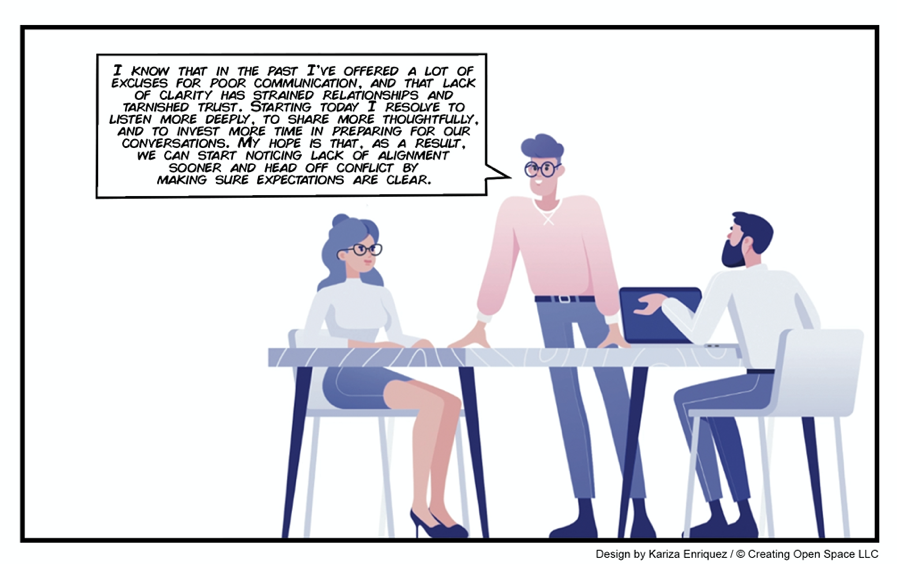Avoiding the Complacency Trap
The world is full of leaders who missed opportunities to make improvements in their organizations. In this article, we explore three psychological mechanisms that fuel complacency:
The Reflexive Loop
Omission Bias
Guilt and Shame
Each of these mechanisms informs practices that can uproot and guard against complacency in leadership. Leaders who leverage these antidotes can prevent small missteps from becoming big problems. Let’s take a look at each.
The Reflexive Loop: We see what we want to see
Complacency is often a result of overlooking something that’s amiss. Specifically, we tend to notice things that confirm our assumptions and beliefs, and tend to miss things that contradict them. For example, when we believe that trust is strong, we’ll notice signs of trust and miss signs of distrust. This phenomenon is called the reflexive loop, and is one component of part of Chris Argyris’s classic Ladder of Inference (Argyris, 1944).
When we default to this cognitively complacent way of observing the people, systems, and practices around us, we fail to notice important trends and events. This is one reason that leaders are wise to surround themselves with people who see things differently and can point out blind spots.The best leaders go one step further and proactively build the capacity to see what they need to see.
How to see what you need to see: To strengthen your powers of observation, start by specifically looking for things that you typically don’t notice. For example, you might watch for impatience, lack of confidence, or pleasing behavior from work colleagues.
Consider listening to your body. The churning in your gut, the tightness in your shoulders, and the hair standing up on your neck are all signals of alarm. Your body will viscerally respond to things that seem out of sorts long before your brain can interpret a situation logically. For a host of additional strategies, pick up a copy of Max Bazerman’s The Power of Noticing: What the Best Leader’s See.
Omission Bias: We favor errors of inaction over errors of action
Complacency is often manifest as an error of omission. Errors of omission are errors of inaction – the failure to make a decision or to respond to a situation. Research shows that humans have a rather significant omission bias – we favor errors of inaction to errors of action. Errors of inaction are viewed as less blameworthy, less intentional, and less immoral than errors of commission. As a case in point, a client of mine recently declined to address an early warning sign of mistrust out of a concern that addressing it would make things worse. To compound this bias, errors of inaction are often not even noticed. Russell Ackoff – a pioneer management professor – once wrote:
“Errors of omission are horses of a different color. Decisions not to do something are seldom made a matter of record. Therefore, it is at best very difficult to become aware subsequently of the fact that a mistake was made, let alone who made it.” (Ackoff,1994)
Omission bias influences leaders to hold back, even when intuition tells them that something is amiss. Even in retrospect, it’s difficult to spot an error of omission. Without a feedback loop, leaders don’t just fail to act once, they fail to act time and time again – until, of course, they are labeled complacent. The best leaders view errors of omission and commission as equally disruptive and detrimental.
How to take omission seriously: A great way to sensitize yourself to errors of omission is to ask your team to delay judgment and activate curiosity around their observations, then call them to your attention. With judgment suspended, observations are easier to share and less threatening and receive, increasing the likelihood that you’ll respond in a positive, reinforcing manner.
Macintosh HD:Users:carylynnlarson:Documents:Creating Open Space:Marketing, Branding, Graphics:Observations of Complacentcy_2.jpg
Guilt and Shame: It’s hard to admit that we missed something
For the reasons discussed above, most errors of omission are not singular events. Even when patterns of omission are brought to our attention, they can be difficult to change. Research on guilt and shame suggests that anything that requires vulnerability – in this case, admitting to missed opportunities – is exponentially difficult. Consider the scenario in which a leader has allowed members of the team to talk behind one another’s backs. By the time the leader realizes that he or she has become complicit with gossip, correcting the behavior feels like an admission of guilt. I have worked with many leaders who were so ashamed of not taking action, that they denied the problem, deflected responsibility, felt paralyzed, and overcompensated. The most capable leaders are those who are able to release themselves from the weight of guilt and shame.
How to move past guilt and shame: To move past guilt and shame, surround yourself with people who have learned to be humble about their own imperfection and who focus on improving themselves as opposed to being perfect. Once you’ve found this tribe, declare your behavioral shift: say what you will start doing differently to improve. Declarations are not just goals – they are goals with purpose, intention, and resolve.
Macintosh HD:Users:carylynnlarson:Documents:Creating Open Space:Marketing, Branding, Graphics:Declaring Complacency.jpg
If declaring your intention to change is painful for you, consider picking up any one or all of Brené Brown’s bestsellers, including The Gifts of Imperfection, Daring Greatly, and The Power of Vulnerability.
In some shape and form, complacency is to blame for nearly all man-made disasters: Exxon Valdez, Rana Plaza building collapse, and The Pacific Garbage Patch to name just a few. Leaders who adopt the strategies discussed here create teams and cultures that guard against and when necessary, confront complacency.
And if this all seems nice but not particularly necessary, consider this: are you being complacent about complacency?
Note: This article was previously published by Forbes.com: https://www.forbes.com/sites/forbescoachescouncil/2019/10/31/how-leaders-can-avoid-the-complacency-trap/


